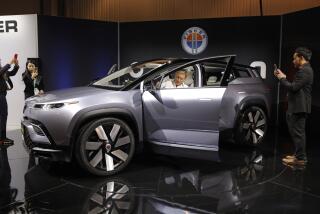Chrysler Leads Charge With U.S.-German Coupe
Almost a year into the Chrysler Group’s far-reaching restructuring program, the U.S. division of DaimlerChrysler is launching an offensive of all-new products aimed at regaining ground with the head-turning allure Chrysler vehicles have shown in the past.
Over six days, the Chrysler Group--composed of Chrysler, Dodge and Jeep--is unveiling three all-new production vehicles, one of them with its engine and significant other parts from its cousin brand, Mercedes-Benz.
Chrysler introduced the Crossfire, a two-seat sports coupe introduced at the Los Angeles International Auto Show last week, and took the wraps off the Pacifica, a “crossover” vehicle that’s half sport-utility vehicle, half station wagon, at the North America International Auto Show in Detroit. Dodge is expected to introduce a performance pickup truck Tuesday in Detroit.
The vehicles will go on sale next year. Joining them is a $20,000 SRT performance version of the Dodge Neon with 205 horsepower that goes 0 to 60 mph in 5.9 seconds.
Chrysler’s decision to build the Crossfire, which it introduced as a concept at the Detroit show just a year ago, appears to be a new--and controversial--statement of intent from the company’s top management in Germany, executives who once swore they would never dilute Mercedes-Benz’s DNA by blending it with Chrysler’s.
The production model of the Crossfire is being pitched as just such a blend--a mix of Route 66 and the autobahn, American design and Teutonic precision.
“It is the first true child of the merger” in 1998 of Germany’s Daimler-Benz and the former Chrysler Corp., said Wolfgang Bernhard, Chrysler Group’s chief operating officer.
Chrysler plans to begin selling the car next year as a 2004 model.
“Bringing it from concept to the showroom in just two years was only possible because we were able to work closely with our sister, Mercedes-Benz,” Bernhard said. “With the connections I have to Stuttgart, we figured stuff out.”
Bernhard, an engineer with an MBA from Columbia University, was dispatched from headquarters in late 2000 as Chrysler’s chief operating officer, along with Chief Executive Dieter Zetsche, after a series of American executives were ousted amid a sea of red ink.
The 41-year-old Bernhard previously headed AMG, the high-performance unit of Mercedes-Benz, and has little patience for endless meetings.
“No focus groups.... Speed, speed, speed and get it done,” he said of the Crossfire.
“It’s an American design, it’s a mainstream American sports car, no question about that. But we take Mercedes parts and pieces and realize that design....Only we, as Chrysler, can do that. Nobody else in the industry can do that,” he said.
“Ford cannot go to Jaguar and get these great components and pieces; GM cannot go to Opel. But we can do that and benefit from it,” Bernhard said. “This will be a new recipe, and I’m very confident that this new mixture that we’re getting is going to be a success.”
The Crossfire is the first of a series of new Chrysler products that will borrow heavily from Mercedes-Benz and from Japan’s Mitsubishi Motor Corp., which DaimlerChrysler now controls. The replacements for the compact Dodge Neon, as well as the Dodge Stratus and Chrysler Sebring mid-size sedans, will be built on Mitsubishi platforms, he said.
There are several reasons for joint development, and saving money by sharing engineering and platform-development costs isn’t the least of them. But paramount is improving the quality of domestic vehicles and boosting consumers’ perception of that quality, Bernhard said.
The renewed product assault comes at a time when the auto maker is regaining some ground in the U.S. market by offering 0% financing and cash-back incentives.
“DaimlerChrysler gained a whopping 5.1 share points in December and 1 point for the full year,” said Merrill Lynch auto industry analyst John Casesa. “The company has re-priced and repackaged its lineup and appears to be taking share from GM.”
But the incentives are costing money that Chrysler can ill afford.
Jim Schroer, Chrysler Group’s executive vice president of sales and marketing, said the company won’t match General Motors Corp.’s new $2,002 cash rebate program for purchases or leases on most GM vehicles.
“We will not make an across-the-board discount giveaway,” Schroer said. “It gets you the maximum short-term sales lift. But that doesn’t maximize sales or profits over time. It wouldn’t be in the best interests of our shareholders to do that.”
Part of the key to Chrysler’s cost-cutting strategy is sharing parts among its brands.
Access to Mercedes components “is great for Chrysler,” said David Bradley, J.P. Morgan’s auto industry analyst in New York. “Whether there’s a negative trade-off for Mercedes is hard to say. There would be some questions of whether Chrysler’s engineering is up to snuff, but knowing Mercedes is in the background will be a big help.”
The Crossfire could be a badly needed hit for Chrysler, said Jeff Schuster, director of North American auto market forecasting for J.D. Power & Associates.
“It is something that needs to happen to further the restructuring of Chrysler and to make it a brand with an image again,” Schuster said. “Chrysler has not been very strong on the car side, and I’m glad Bernhard says it will be an available car and not one of those untouchables that’s put out there just for people to drool over.”
The Crossfire was designed in the U.S. by Chrysler but will be assembled in Germany by coach builder Karmann.
Visually, the car pays homage to so-called boat-tailed speedsters of the 1930s, with a low, squat stance and long hood whose lines sweep back through rear quarter panels, which wrap around to meet the sharply sloped fast-back rear deck in a tight, almost pointed, tail.
Power will come from a 215-horsepower, 3.2-liter V-6 engine from the Mercedes E-Class with a choice of either a six-speed manual or five-speed electronically controlled automatic transmission.
“It should be a very credible car,” said George Peterson, president of AutoPacific Inc., an automotive market research firm in Tustin. “Building it that way says to the consumer that there is a very different quality equation for future Chrysler products than there is today.”
During a walk Thursday through the Los Angeles show, Bob Lutz--the former Chrysler vice chairman hired by General Motors late last year to lead a revival of its stale passenger car lines--said he was “favorably impressed” with the Crossfire, which was developed after he left Chrysler from an earlier large-car concept he had overseen.
The look of the two-seater, he said, is that of “a bunched-up cat that’s ready to pounce.”
The sleek Pacifica is a much larger car that has a third row of seats so it can fit up to six people. Like Chrysler’s wildly popular PT Cruiser, the Pacifica is meant to defy categorization, though it’s safe to call it a cross between a station wagon and an SUV. It has low step-in height, plush seating, a number of comfort and safety amenities and car-like handling.
Pacifica does not fit into any existing automotive category, CEO Zetsche said.
“It’s an all-new segment that will follow the success of our original minivan and PT Cruiser. The Pacifica is a sports tourer with the right formula of proportions, packaging, performance and appearance that will set it far apart from our competition,” he said.
Chrysler won’t release pricing information other than to say the Pacifica will be $25,000-plus.
*
Jones reported from Detroit and O’Dell from Los Angeles.






